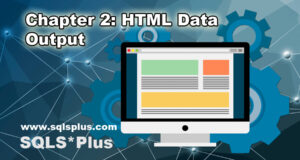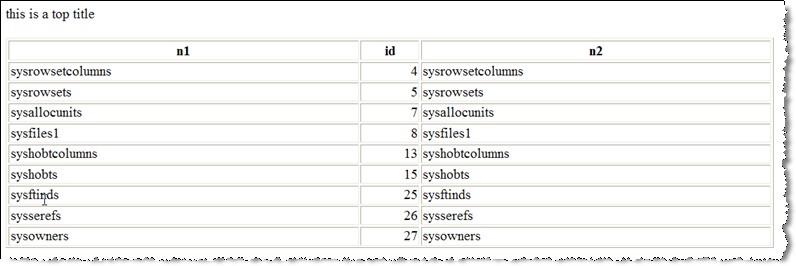REQUEST COMPLIMENTARY SQLS*PLUS LICENCE
Chapter 2: HTML Data Output

SQLS*Plus for SQL Server Data Output – HTML Data Output, CSV Data Output, JSON Data Output, Vertical Data Output, and Column Autoformatting.
HTML Data Output
Use “set markup html on|off” command to output data in HTML format
Sample SQL script for HTML output:
D:\sqlsplus>type t2.sql
set pages 10
ttitle LEFT 'this is a top title'
set markup html on
spool xx.htm
select top 25 name n1, id, name n2 from sysobjects;
spool off
set markup html off
host xx.htm
HTML output:

CSV Data Output
Use “set output csv” command to output data in CSV format.
Sample SQL script for CSV output:
0:sa@192.168.1.160> set output csv
0:sa@192.168.1.160> set head off
0:sa@192.168.1.160> set pages 0
CSV output:
0:sa@192.168.1.160> select name,crdate from sys.sysobjects;
"sysrowsetcolumns","2005-10-14 01:36:15.923",
"sysrowsets","2005-10-14 01:36:15.910",
"sysallocunits","2005-10-14 01:36:15.910",
"sysfiles1","2003-04-08 09:13:38.093",
"syshobtcolumns","2005-10-14 01:36:15.940",
"syshobts","2005-10-14 01:36:15.923",
"sysftinds","2005-10-14 01:36:17.063",
"sysserefs","2005-10-14 01:36:15.940",
"sysowners","2005-10-14 01:36:17.050",
"sysprivs","2005-10-14 01:36:15.877",
"sysschobjs","2005-10-14 01:36:15.987",
…
JSON Data Output
Use “set output json” command to output data in JSON format.
Sample SQL script for JSON output:
0:sa@192.168.1.160> set output json
0:sa@192.168.1.160> set head off
0:sa@192.168.1.160> set pages 0
JSON output:
0:sa@192.168.1.160\SQLSERVER2008> select * from department order by dept_id;
{ "dept_id" : "10", "last_name" : "Jackson", "salary" : "50000", "bonus" : "12501.78" }
{ "dept_id" : "10", "last_name" : "Sally", "salary" : "55000", "bonus" : "13750" }
{ "dept_id" : "10", "last_name" : "Major", "salary" : "30000", "bonus" : "7500" }
{ "dept_id" : "10", "last_name" : "Mimon", "salary" : "38000", "bonus" : "9500" }
{ "dept_id" : "10", "last_name" : "Karla", "salary" : "58000", "bonus" : "14500" }
{ "dept_id" : "10", "last_name" : "Major", "salary" : "34000", "bonus" : "8500" }
{ "dept_id" : "10", "last_name" : "Mason", "salary" : "39000", "bonus" : "9750" }
{ "dept_id" : "10", "last_name" : "Mason", "salary" : "39000", "bonus" : "9750" }
{ "dept_id" : "10", "last_name" : "Jackson", "salary" : "50000", "bonus" : "12501.78" }
{ "dept_id" : "10", "last_name" : "Sally", "salary" : "55000", "bonus" : "13750" }
{ "dept_id" : "10", "last_name" : "Major", "salary" : "30000", "bonus" : "7500" }
{ "dept_id" : "10", "last_name" : "Mimon", "salary" : "38000", "bonus" : "9500" }
{ "dept_id" : "10", "last_name" : "Karla", "salary" : "58000", "bonus" : "14500" }
{ "dept_id" : "10", "last_name" : "Major", "salary" : "34000", "bonus" : "8500" }
{ "dept_id" : "10", "last_name" : "Mason", "salary" : "39000", "bonus" : "9750" }
{ "dept_id" : "10", "last_name" : "Mason", "salary" : "39000", "bonus" : "9750" }
{ "dept_id" : "20", "last_name" : "Smith", "salary" : "45000", "bonus" : "23000" }
{ "dept_id" : "20", "last_name" : "<NULL>", "salary" : "65000", "bonus" : "29000" }
{ "dept_id" : "20", "last_name" : "Major", "salary" : "78000", "bonus" : "" }
{ "dept_id" : "20", "last_name" : "Smith", "salary" : "75000", "bonus" : "18750" }
{ "dept_id" : "20", "last_name" : "Jefferson", "salary" : "90000", "bonus" : "22500" }
{ "dept_id" : "20", "last_name" : "Smith", "salary" : "45000", "bonus" : "23000" }
{ "dept_id" : "20", "last_name" : "<NULL>", "salary" : "65000", "bonus" : "29000" }
{ "dept_id" : "20", "last_name" : "Major", "salary" : "78000", "bonus" : "" }
{ "dept_id" : "20", "last_name" : "Smith", "salary" : "75000", "bonus" : "18750" }
{ "dept_id" : "20", "last_name" : "Jefferson", "salary" : "90000", "bonus" : "22500" }
{ "dept_id" : "30", "last_name" : "Sandy Jackson", "salary" : "38000", "bonus" : "19000" }
.…
Vertical Data Output
Use “set vout on” command to output data in vertical format, where each column is printed on its own line. Vertical output format is helpful when outputting data from a tables with many columns.
Sample SQL script for CSV output:
0:sa@192.168.1.160> set vout on
Vertical output:
0:sa@192.168.1.160> select name,crdate from sys.sysobjects;
name | sysrowsetcolumns
crdate| 2005-10-14 01:36:15.923
name | sysrowsets
crdate| 2005-10-14 01:36:15.910
name | sysallocunits
crdate| 2005-10-14 01:36:15.910
name | sysfiles1
crdate| 2003-04-08 09:13:38.093
…
Column Autoformatting
Use “set autoformat <table>” command to automatically format table columns to optimally size column sizes for character and numeric fields.
set autoformat supports 2 parameters:
maxsize – defined maximum size for long character columns, default is 40 characters sample – defined sample size for table data selection to identify optimal columns sizes, default is 5%.
Sometime default sample is not enough and for small table recommendation is to set sample to 50%-100%.
Sample table columns autoformatting:
0:sa@192.168.1.160\SQLSERVER2008> set autoformat SalesLT.Customer
Unable to create automatic column formatting. Please increase sample size and retry:
0:sa@192.168.1.160\SQLSERVER2008> set autoformat SalesLT.Customer sample 50
0:sa@192.168.1.160\SQLSERVER2008> col
COLUMN MIDDLENAME
FORMAT A10
COLUMN CUSTOMERID
FORMAT 9999999999
COLUMN PASSWORDHASH
FORMAT A40
COLUMN SALESPERSON
FORMAT A24
COLUMN COMPANYNAME
FORMAT A36
COLUMN PASSWORDSALT
FORMAT A12
COLUMN TITLE
FORMAT A5
COLUMN LASTNAME
FORMAT A22
COLUMN FIRSTNAME
FORMAT A15
COLUMN SUFFIX
FORMAT A6
COLUMN EMAILADDRESS
FORMAT A34
COLUMN PHONE
FORMAT A19
Download SQLS*Plus manual in PDF format
MORE NEWS
PreambleNoSql is not a replacement for SQL databases but is a valid alternative for many situations where standard SQL is not the best approach for...
PreambleMongoDB Conditional operators specify a condition to which the value of the document field shall correspond.Comparison Query Operators $eq...
5 Database management trends impacting database administrationIn the realm of database management systems, moreover half (52%) of your competitors feel...
The data type is defined as the type of data that any column or variable can store in MS SQL Server. What is the data type? When you create any table or...
PreambleMS SQL Server is a client-server architecture. MS SQL Server process starts with the client application sending a query.SQL Server accepts,...
First the basics: what is the master/slave?One database server (“master”) responds and can do anything. A lot of other database servers store copies of all...
PreambleAtom Hopper (based on Apache Abdera) for those who may not know is an open-source project sponsored by Rackspace. Today we will figure out how to...
PreambleMongoDB recently introduced its new aggregation structure. This structure provides a simpler solution for calculating aggregated values rather...
FlexibilityOne of the most advertised features of MongoDB is its flexibility. Flexibility, however, is a double-edged sword. More flexibility means more...
PreambleSQLShell is a cross-platform command-line tool for SQL, similar to psql for PostgreSQL or MySQL command-line tool for MySQL.Why use it?If you...
PreambleWriting an application on top of the framework on top of the driver on top of the database is a bit like a game on the phone: you say “insert...
PreambleOracle Coherence is a distributed cache that is functionally comparable with Memcached. In addition to the basic function of the API cache, it...
PreambleIBM pureXML, a proprietary XML database built on a relational mechanism (designed for puns) that offers both relational ( SQL / XML ) and...
What is PostgreSQL array? In PostgreSQL we can define a column as an array of valid data types. The data type can be built-in, custom or enumerated....
PreambleIf you are a Linux sysadmin or developer, there comes a time when you need to manage an Oracle database that can work in your environment.In this...
PreambleStarting with Microsoft SQL Server 2008, by default, the group of local administrators is no longer added to SQL Server administrators during the...















